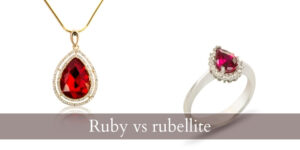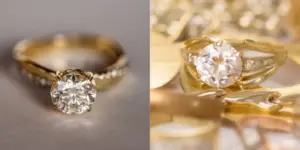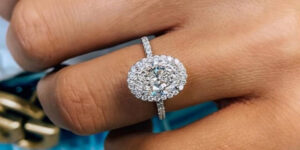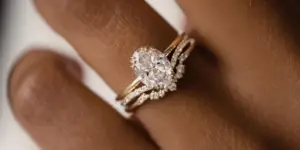Alexandrite has captured the hearts of many, and its beautiful color shifting ability is pretty incredible. Blue-green by one light, reddish-purple by another. Green in one light, orange-red by another. There is no single color present in alexandrite and trying to determine its color is difficult.
What what color is alexandrite, really ? What is the one color is usually shows, and are the other colors just an illusion ? Does the stone actually change colors ? Let’s take a look at alexandrite’s many colors and see for ourselves.
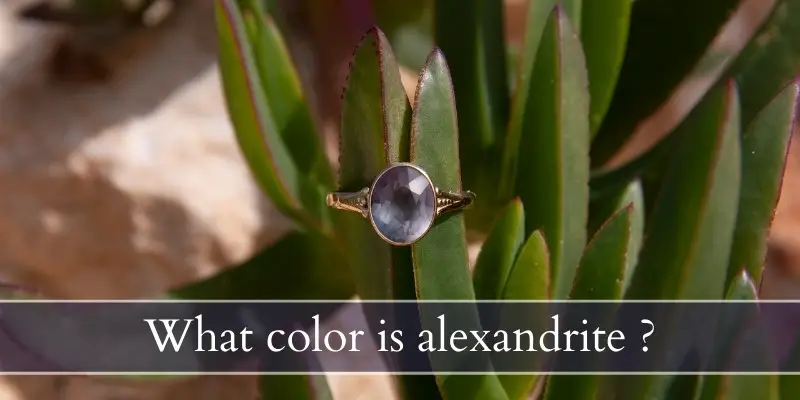
What color is alexandrite ?
Fine-quality alexandrite appears blue-green (teal) in outdoor light, and reddish-purple (raspberry magenta) in indoor light. Lower quality alexandrite shows less blue, and instead ranges from light green (outdoors) to reddish-brown (indoors).
The reason behind this range in alexandrite’s color shifting ability is its composition, or rather how much of the aluminum was replaced by chromium ions within the crystal.
Fine quality alexandrite that changes color dramatically from green to red is very rare. Green to brownish-red is more commonly found, as far as natural stones go. Unlike many colored gems, alexandrite is never heat treated or irradiated to get a better color.
Synthetic alexandrite colors
Nearly all alexandrite on the market is simulated or lab grown. Natural alexandrite truly is rare, and expensive. So let’s take a look at how the color behaves in simulated and lab grown alexandrite, because it’s different from natural alexandrite. There are two types of synthetic alexandrite: corundum-based and chrysoberyl-based.
Read also: Alexandrite Engagement Ring Meaning
Corundum-based alexandrite is simply lab-grown corundum that has been imbued with vanadium to get a color shift. This color shift is beautiful, ranging from a very saturated teal to purple, but will never show green under any light, be it outdoor or indoor lighting.
Chrysoberyl-based alexandrite is a more believable variant, in that it shows color that are closer to natural alexandrite. If you have a strong magnifying glass you would be able to see small striations or swirls within the crystal, due to the way it was formed in the crucible.
Why does alexandrite change color ?
Alexandrite appears to change colors because of the warmth of the light that enters the crystal. Its color change is actually a sort of optical illusion, as this crystal is capable of absorbing both red and blue light, depending on what the light source is.
Humans are adapted to see shades of green best, which is closer to the blue (short) light spectrum. So alexandrite will appear bluish-green in outdoor light like in high noon, where light is neutral (neither red nor blue). If you bring alexandrite inside, where the light is incandescent (towards the red end of the spectrum), it does not have a lot of blue or green to absorb. So alexandrite will appear reddish.
So alexandrite does not change color within itself, rather the lighting in which you view the alexandrite, as well as the angle of the stone relative to your eyes, is what makes the stone appear to change colors. It reflects different color depending on how you look at it and what the lighting is.
The stronger and more dramatic the color shift, the more precious the stone becomes.
Why is alexandrite so expensive ?
Alexandrite is an expensive gemstone because it is incredibly rare in nature. This, combined with the appeal of its color-shifting ability has made alexandrite very valuable. Fine alexandrite (teal to magenta shift) is anywhere from $28,000-30,000 per carat, while a lower quality alexandrite with less color shift can be as little as $3000 per carat.
Like any other gemstone, alexandrite is graded for cut, clarity, and carat. But color is the most important for this particular gemstone, as it’s the most impressive thing about it. This is why a better color will always fetch a higher price.
Most alexandrite jewelry is made with lab grown alexandrite
You may be wondering why you’ve found alexandrite rings at under $100 is the natural stone is so cheap. You already know. It’s not actually alexandrite, but rather simulated alexandrite, either chrysoberyl-based or corundum-based. You have a higher chance of finding corundum-based simulated alexandrite as its color range has become the norm for alexandrite in affordable jewelry.
Alexandrite alternatives you can try
Natural alexandrite can be very, very expensive and synthetic alexandrite does not show the exact same range of color as the natural stone. But there are a couple of options you can try if you’re looking for a 100% natural color-shifting gem. There are at least two other color-shifting natural gemstones, but they’re a bit more obscure than alexandrite. Their color shift is also a bit different, but still very pleasing to the eye.
Color change garnet
Garnets are definitely not the most expensive gemstones out there, but there are natural color change garnets that do hike up the price. You can find these beauties for $160-200 per carat. The thing about color change garnets is that they don’t come in one specific color shift, but rather they come in several.
Dark blue to light pink, blue to purple, green to yellow, dark washed blue to light raspberry, green to purple, greenish-brown to orange, and so on. The color change happens the same way it does in alexandrite: you expose the gem to another source of light and it will shift its color accordingly. Generally incandescent lights (yellow-red) will bring out oranges, pinks, purples, and red in these garnets. Neutral or blue light will bring the indigo-green spectrum.
Diaspore (zultanite)
A less known gemstone, zultanite is actually quite impressive. It was discovered in Turkey and named so in honor of the sultans of the Ottoman empire. This gem is usually very clear, and it comes in a very different color range than alexandrite or garnets. It can show up to three colors at once ! Most of the time zultanite shows as yellowish-green to light amber, with flashes of salmon pink. In mixed light it shows all colors at once, and in incandescent light it shows the yellow-pink spectrum.
$250-300 per carat is usually the price for a very good zultanite gem, with 80 carat pieces going as high as $800k ! Really these gems are one of a kind and very impressive, yet not exactly easy to find unless you’re working with a very experienced jeweler.

I’m the main author for jewelrymaterialguide.com. I started this site after we did tons of research before our wedding and noticed that there is information about rings, jewelry, and so on that is really hard to find on the internet.

